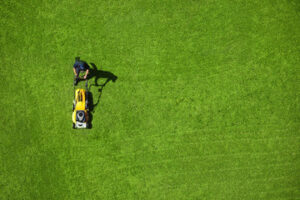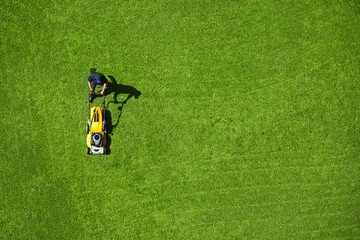Overgrown grass attracts rodents, ants and mosquitoes that pose a health risk. It also blocks views of obstacles and reduces safety on bare lawns.
A healthy lawn can withstand some pest infestations like turf caterpillars and grub worms, but excessive infestations should be controlled. Spring is the best time to seed a lawn. Contact Lawn Care Kentucky for professional help.
Lawns require regular mowing, watering and fertilization to thrive. These tasks can be difficult to keep up with when balancing a busy schedule. A lawn care program can help you achieve a healthy lawn while saving you time and energy.
The best way to ensure your grass is healthy is to implement proper cultural practices. These include mowing, fertilizing, aerating and weed control. This will promote vigorous and healthy turf that is resistant to weeds, drought and erosion.
While it may seem like a good idea to cut your grass as short as possible, this can be harmful. Short grasses are less able to capture sunlight and can be more susceptible to disease, so it’s important to mow your lawn at the right height. Generally, it’s best to mow your grass at a height of 3 inches or higher.
It’s also a good idea to aerate your lawn regularly, which helps reduce soil compaction and encourages root growth. In addition to aerating, you should fertilize your lawn in the spring and fall to promote dense and healthy turf. Inspecting your lawn for weeds and diseases is also important, so if you have any weed or insect problems, you should use a spot treatment or hand pull them as soon as they appear.
Integrated Pest Management programs use safe and effective pest control solutions that are tailored to your specific landscape. They are designed to prevent pests from entering your lawn and causing damage before they become out of control, which can save you both time and money in the long run. You can find more information on this type of lawn care in Bergen County by talking to a professional.
Irrigation
The right lawn irrigation system is vital for the health of your plants. It provides water to your lawn in a way that minimizes waste and maximizes results. There are a variety of irrigation systems to choose from, each with their own advantages and disadvantages. Consider the initial investment, operating costs, and maintenance expenses when deciding which type of system is right for your landscape.
Irrigation is important for all lawn treatments, including mowing, fertilizing, and pest control. However, each treatment has its own specific application methods. For example, applying a pre-emergent weed control product in the spring requires spreading granular products over your lawn, while spray applications work better on broadleaf weeds like dandelions and clover.
For manual lawn watering, a garden hose with a trigger nozzle is a good choice. This helps reduce water wastage by allowing you to control how much water is sprayed. A nozzle with a spray pattern is also helpful to avoid spraying puddles that can damage the turf. For optimal efficiency, water your lawn in short sessions. Watering too frequently or infrequently can lead to insufficient hydration, while watering too long can result in shallow root systems.
If you are planning to install an automated sprinkler system, a soil test will provide valuable information about your soil and grass type. The test will tell you the relative proportions of sand, silt, and clay in your soil, and this will influence how often you need to water your lawn.
If you are watering your lawn manually, use a screwdriver to check how deep the water penetrates after about 15 minutes of irrigation. This allows you to keep track of how far the water reaches, so you can make adjustments as needed.
Fertilization
Depending on climate, soil conditions, and turf grass species, the amount of nitrogen fertilizer required for healthy growth can vary. A lawn with a low maintenance objective should be fertilized 0 to 2 times per season with nitrogen (N) at an annual rate of 0 to 4 pounds per 1,000 square feet of turf area; a moderate maintenance program would require fertilization 3 to 6 times per season with N at an annual rate of 3 to 5 pounds per 1,000 square feet of turf area.
The type of fertilizer used depends on the results of a soil test, which determines how well your lawn’s soil will absorb nutrients and its pH level. Soil tests also tell you whether your soil is predominantly sand, clay, or loamy and indicate the organic matter percentage of the soil.
A lawn that’s well-fertilized promotes strong, healthy turf that resists weeds and pests. It also enables the homeowner to reduce the need for chemical sprays and maintain a healthy, natural environment that enhances the beauty of the property.
The best time to apply a lawn treatment is during the spring for cool-season grasses and in late summer for warm-season grasses. Liquid fertilizer is easier to use because it spreads more evenly, but it requires more frequent application than granular fertilizer. It’s important to follow the product’s instructions for applying it and to avoid applications just prior to a rain storm or on windy days, which can wash excess fertilizer into paved areas, lakes, and streams.
Regular watering keeps a lawn green, but overwatering promotes disease and insect pest problems. A good rule of thumb is to water the lawn until the top 12 inch of soil is saturated but not soaked. Avoid watering in the evening because it evaporates too quickly and prevents the lawn from soaking up necessary nutrients.
Aeration
Aeration is a critical lawn care treatment that alleviates soil compaction and reduces thatch, allowing the grass to receive the air, water and nutrients it needs. Thatch is a layer of organic material consisting of fallen leaves, dead grass and stems that builds up over time and prevents the grass from receiving proper moisture. Aerating the lawn loosens thatch and allows the soil to breathe, encouraging root growth and accelerating nutrient delivery from fertilization.
Aerated lawns are healthier and more resistant to stress, drought, disease, weeds and foot traffic. It is recommended that a lawn is aerated every two to three years, although more frequent aeration may be necessary in some cases. It is best to do aeration in the early spring or fall for cool-season grasses (Kentucky bluegrass, tall fescue, and fine fescue) or in late spring or summer for warm-season grasses (Bermudagrass, St. Augustinegrass, and zoysiagrass).
Liquid aeration is recommended in the spring, as it is less invasive than core aeration. This is ideal for yards with heavy traffic, as it allows the grass to recover before the summer heat sets in. Core aeration is done with a machine that perforates the lawn, removing small plugs of soil and thatch. The holes allow the grass to better absorb water and nutrients from the soil, as well as improving overseeding results by allowing seed to reach the ground more easily.
Regular aeration also helps keep harmful lawn diseases at bay by disrupting the fungus that causes them, which can be exacerbated by compacted soil. In addition to aerating, we recommend a fungicide application as part of your lawn care regimen in the fall and spring.
Inspecting
Regularly monitoring your lawn’s progress and making adjustments is important to ensure the health and beauty of your landscape. It’s a good idea to keep a lawn journal where you can record the date of each treatment, type of treatment, and any observations that you may have.
